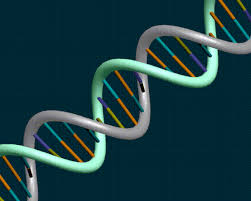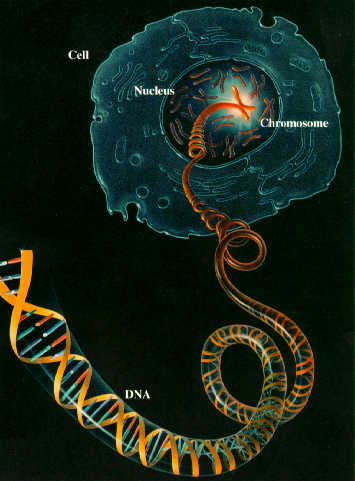Biology






- Q: Compare And Contrast The Prokaryotic And Eukaryotic Genomes
The eukaryotic genome is diploid but the prokaryotic genome is haploid. The eukaryotic genome has multiple origins of replication but the prokaryotic genome has only one origin of replication. The eukaryotic genome may have more than one chromosome but...
- Genes Are Dna
Key Terms:The genome is the complete set of sequences in the genetic material of an organism. It includes the sequence of each chromosome plus any DNA in organelles. Nucleic acids are molecules that encode genetic information. They consist of a series...
- #37 Summary Of Genetic Control
1. DNA and RNA are polynucleotides, made up of long chains of nucleotides. 2. A nucleotide contains a pentose sugar, a phosphate group and a nitrogen-containing base. In RNA the sugar is ribose, and in DNA it is deoxyribose. 3. A DNA molecule consists...
- # 34 Dna Structurer And Replication
DNA molecule consists of nucleotides in which the sugar component is deoxyribose whereas the RNA molecule has nucleotides in which the sugar is a ribose. Nucleotides Roles: are monomers for nucleic acid polymers, such as DNA and RNA....
- # 33.2 Nucleic Acids And Protein Synthesis - Syllabus 2016
6.1 Structure and replication of DNA 6.2 Protein synthesis Nucleic acids have roles in the storage and retrieval of genetic information and in the use of this information to synthesise polypeptides. DNA is an extremely stable molecule that...
Biology
Amazing DNA Facts
1. Humans have roughly 100,000,000,000,000 (100 trillion cells). Each cell (except red blood cells) has a nucleus. Each nucleus contains 46 (23 pairs) of chromosomes (in gametes such as sperm and ovum only 23 chromosomes are present). These chromosomes contain the amazing molecule, the DNA (Deoxyribo Nucleic Acid).
2. DNA is considered as the ?blueprint? of life.
3. DNA is found in all living things except some RNA viruses.
4. Generally a cell is microscopic. Its size is at micron (10-6 m) level. The diameter of nucleus inside in it is about 6 micrometers (?m). What will be the length of DNA present in such a nucleus? If we unwound and tied together, the DNA strands in a cell nucleus would be about 2 metre (6 feet)!!! But its width would be only 50 trillionths of an inch.
5. If you unraveled your entire DNA from all of your cells and laid out the DNA end to end, the strand can be stretched from the Earth to the Sun hundreds of times!!
6. If you uncoil the entire DNA in all your cells, you could reach the moon 6000 times!
7. You can accommodate about 25,000 DNA strands side by side in the width of a single adult hair. (The diameter of human hair ranges from 17 to 181 µm whereas it is 20 Å for DNA).
8. Do you know what a gene is? It?s a functional segment of DNA that controls a particular character.
9. The entire DNA in 23 chromosomes of a human cell is called human genome. It means we have 2 genomes in each cell. Such cells are known as diploid cells. But the sperm and ovum have only one genome (remember they have only 23 chromosomes). Such cells are known as haploid cells.
10. In a human cell there are about 30,000 genes.
11. Average gene consists of 3000 bases.
12. Largest known human gene is dystrophin on X-chromosome. It contains 2.4 million bases.
13. Functions of over 50% of discovered genes are unknown.
14. Chromosome I has most genes (2968 genes) and Y chromosome has the fewest (231 genes).
15. What is the chemical content of a DNA? DNA is made up of millions of chemical building blocks called nucleotides. Each nucleotide contains 3 types of chemicals- a nitrogen base, a deoxyribose sugar and a phosphate group. There are 4 types of nitrogen bases in DNA- Adenine (A), Thymine (T), Cytosine (C) and Guanine (G). So the types nucleotides are also vary based on the type of nitrogen base in it.
16. Human genome, i.e. DNA in 23 chromosomes of a cell, contains about 3165 million nucleotides!!
17. In DNA, there are millions of steps formed of a pair of nitrogen bases. Adenine always pairs with thymine and Cytosine always pairs with cytosine. It means the amount of adenine is equal to thymine. Similarly the amount of cytosine is equal to guanine.
18. 99.9% nucleotide bases are identical in all people i.e. 99.9% of our DNA sequence is the same as other humans. 0.1% is what makes each of us unique. Identical twins share 100% of their genes. Siblings share 50% of their genes. A parent and child share 50% of their genes.
19. Our DNA has very close similarity with the DNA of other species. See them below:
Species | How many genes do we share with them? |
Chimpanzee | 98% |
Mouse | 92% |
Zebra fish | 76% |
Fruit fly | 51% |
Weed (thale cress) | 26% |
Bacteria (E. coli) | 18% |
20. Human DNA is closer to a rat than a cat.
21. Less than 2% of the genome codes for proteins. i.e., Genes make up only about 2-3% of our genome.
22. The 4 nitrogen bases are considered as the letters in the genetic language. The sequence of nitrogen bases (in nucleotides) forms the genetic codes as the letters form the words in a language. In a genetic code there will be only 3 bases. Each code is responsible for the production of a particular amino acid. Many amino acids are linked in a specific sequence to form a protein. This protein is expressed as a particular character of the individual. On the other hand, the four letters in the DNA alphabet - A, C, G and T - are used to carry the instructions for making all organisms.
23. There are approximately 3 billion chemical letters (bases) in the DNA code in every cell in your body.
24. If you tried typing the whole genetic code continuously at the speed of 200 letters per minute it would take 29 years to finish!
25. One million bases of DNA sequence data is equivalent to 1 megabyte (MB) of computer data storage space.

26. James Watson and Francis Crick explained the structure of DNA. According to them, DNA is a double helix i.e. like a twisted ladder.
27. A complete 3 billion base genome would take 3 gigabytes of storage space.
28. DNA can self-replicate using cellular machinery made of proteins.
29. The segment of DNA designated a gene is made up of exons and introns. Exons have the code for making proteins. Introns (junk DNA) are intervening sequences that do not code for making proteins.
30. The human genome sequence generated by the private genomics company Celera was based on DNA samples collected from five donors who identified themselves only by race and sex.
31. If all three billion letters in the human genome were stacked one millimeter apart, they would reach a height 7,000 times the height of the Empire State Building.
32. Changes in the DNA sequence are called mutations. Many thing can cause mutations, including UV irradiation from the sun, chemicals like drugs, etc.
33. DNA is affected by the environment; environmental factors can turn genes on and off.
34. The technique to identify the similarities of the DNA fragments of 2 individuals are called DNA fingerprinting. It is developed by Alec Jeffreys (1985). It is used as a forensic tool to solve paternity, rape, murder etc. it can also be used for the diagnosis of genetic diseases and to determine phylogenetic status of animals.
35. DNA can be extracted from many different types of samples: blood, cheek cells, urine. You can extract DNA at home from fruit and even your own cheek cells.
36. DNA can be stored either as cells on a cotton swab, buccal brush, or frozen blood or in extracted form.
37. In forensics, DNA analysis usually looks at 13 specific DNA markers (segments of DNA).
38. A DNA fingerprint is a set of DNA markers that is unique for each individual except identical twins.
39. Many countries, including the US and UK, maintain a DNA database of convicted criminals.
40. Polymerase chain reaction (PCR) is used to amplify a sample of DNA so that there are more copies to analyze.
41. We eat DNA every day because the vegetables, fruits, meat, fish etc contain DNA.
42. DNA testing is used to authenticate food like caviar and fine wine.
43. Genetically modified crops have DNA from another organism inserted to give the crops properties like pest resistance.
DNA is like an engineer! It draws a plan known as RNA. It constructs a building called Protein!! A mistake made by an engineer results in the mistake in his plan which in turn affects the building. Thus any mutation (change or mistake) in DNA results in change in RNA which synthesizes wrong protein leading to genetic disorders.
- Q: Compare And Contrast The Prokaryotic And Eukaryotic Genomes
The eukaryotic genome is diploid but the prokaryotic genome is haploid. The eukaryotic genome has multiple origins of replication but the prokaryotic genome has only one origin of replication. The eukaryotic genome may have more than one chromosome but...
- Genes Are Dna
Key Terms:The genome is the complete set of sequences in the genetic material of an organism. It includes the sequence of each chromosome plus any DNA in organelles. Nucleic acids are molecules that encode genetic information. They consist of a series...
- #37 Summary Of Genetic Control
1. DNA and RNA are polynucleotides, made up of long chains of nucleotides. 2. A nucleotide contains a pentose sugar, a phosphate group and a nitrogen-containing base. In RNA the sugar is ribose, and in DNA it is deoxyribose. 3. A DNA molecule consists...
- # 34 Dna Structurer And Replication
DNA molecule consists of nucleotides in which the sugar component is deoxyribose whereas the RNA molecule has nucleotides in which the sugar is a ribose. Nucleotides Roles: are monomers for nucleic acid polymers, such as DNA and RNA....
- # 33.2 Nucleic Acids And Protein Synthesis - Syllabus 2016
6.1 Structure and replication of DNA 6.2 Protein synthesis Nucleic acids have roles in the storage and retrieval of genetic information and in the use of this information to synthesise polypeptides. DNA is an extremely stable molecule that...
